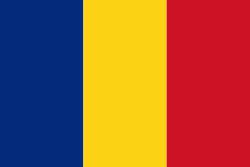Bistra (Comuna Bistra)
Bistra (Bistra; Бистрий; Быстрый; Petrovabisztra) is a commune in Maramureș County, Maramureș, Romania. The Ukrainian border is located to the north of the commune. It is made up of three villages: Bistra (commune seat), Crasna Vișeului (Petrovakraszna; Красна Вишовська) and Valea Vișeului (Visóvölgy; Вишiвска Дοлина; Вишовська Долина). The first documentary mention of the settlement dates to 1411.
The name Bistra comes from the Valea Bistrei river, with its spring in the Hodea (Hovdea) mountain peak.
The first documented mention of the village's population was in 1882, with 550 people living there. By 1896, the population had grown to 661, out of which 470 were Greek Catholic, 38 Roman Catholic and 153 Jews. In 1913, the village had a recorded population of 672, 511 being Ukrainians. The settlement continues to have a Ukrainian majority, the biggest demographic shift being the diminishing of the Jewish population.
The name Crasna Vișeului is believed to derive from the Ukrainian words for beautiful (krasnein, krasna, krasne), tied with the name of the river Crasna Frumuseaua. The river consists of two streams, one with its spring in Pop Ivan mountain Peak, and the other in Șerban-Topolev-Polonica peak. The two merge, forming a fast flowing clear river, hence the name, which eventually flows into the Vișeu river. The first mention of Crasna Vișeului village dates back to 1411 in the "Diploma of Robert, King of Hungary", which calls it the domain of the successors of Dragoș and Bogdan. According to documents of the time, the village bore the name of Frumosava in 1882. Between the XIV and XIX centuries the settlement belonged to the nearby village of Petrova. Between 1945 and 1968 the village was autonomous, but ever since 1968, Crasna Vișeului has been part of Bistra commune.
As a settlement, Valea Vișeului 's existence has been documented since the beginning of the XV century. Its name derives from the Vișeu river and the word Valea (Valley in Romanian, Долина (r. Dolyna) in Ukrainian). Throughout its history, the village went through numerous name changes: Viso-Vișeu, Visovelidi, Valea-Vișeului, Fehei Potoc. Despite the lack of clear information, it is believed the original settlers in this area of the Tisza river bank were Hutsuls.
Early in their history, all three villages were assigned under Petrova, as the locals were likely the slaves (robi) of Petrovan nobles.
Between 1985 and 1989, a group of archeologists uncovered, in a place called Uloha, objects made of bronze that date back to the XI century. These objects are now in the custody of the Sighetu Marmației Museum of History and are the oldest records of human settlement in the area.
The name Bistra comes from the Valea Bistrei river, with its spring in the Hodea (Hovdea) mountain peak.
The first documented mention of the village's population was in 1882, with 550 people living there. By 1896, the population had grown to 661, out of which 470 were Greek Catholic, 38 Roman Catholic and 153 Jews. In 1913, the village had a recorded population of 672, 511 being Ukrainians. The settlement continues to have a Ukrainian majority, the biggest demographic shift being the diminishing of the Jewish population.
The name Crasna Vișeului is believed to derive from the Ukrainian words for beautiful (krasnein, krasna, krasne), tied with the name of the river Crasna Frumuseaua. The river consists of two streams, one with its spring in Pop Ivan mountain Peak, and the other in Șerban-Topolev-Polonica peak. The two merge, forming a fast flowing clear river, hence the name, which eventually flows into the Vișeu river. The first mention of Crasna Vișeului village dates back to 1411 in the "Diploma of Robert, King of Hungary", which calls it the domain of the successors of Dragoș and Bogdan. According to documents of the time, the village bore the name of Frumosava in 1882. Between the XIV and XIX centuries the settlement belonged to the nearby village of Petrova. Between 1945 and 1968 the village was autonomous, but ever since 1968, Crasna Vișeului has been part of Bistra commune.
As a settlement, Valea Vișeului 's existence has been documented since the beginning of the XV century. Its name derives from the Vișeu river and the word Valea (Valley in Romanian, Долина (r. Dolyna) in Ukrainian). Throughout its history, the village went through numerous name changes: Viso-Vișeu, Visovelidi, Valea-Vișeului, Fehei Potoc. Despite the lack of clear information, it is believed the original settlers in this area of the Tisza river bank were Hutsuls.
Early in their history, all three villages were assigned under Petrova, as the locals were likely the slaves (robi) of Petrovan nobles.
Between 1985 and 1989, a group of archeologists uncovered, in a place called Uloha, objects made of bronze that date back to the XI century. These objects are now in the custody of the Sighetu Marmației Museum of History and are the oldest records of human settlement in the area.
Map - Bistra (Comuna Bistra)
Map
Country - Romania
 |
 |
| Flag of Romania | |
Europe's second-longest river, the Danube, rises in Germany's Black Forest and flows southeasterly for 2857 km, before emptying into Romania's Danube Delta. The Carpathian Mountains cross Romania from the north to the southwest and include Moldoveanu Peak, at an altitude of 2544 m.
Currency / Language
| ISO | Currency | Symbol | Significant figures |
|---|---|---|---|
| RON | Romanian leu | lei | 2 |
| ISO | Language |
|---|---|
| HU | Hungarian language |
| RO | Romanian language |















